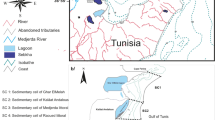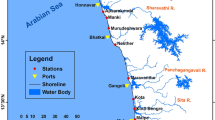Abstract
The estuary can be considered as environments characterized by high productivity and uncommensurable ecological value. However, marine ecosystems are also subjected to high human pressures that increase their vulnerability. The aim of this work is to analyze grain size trend of sediment due to the action of the main hydrodynamic condition. The spatial distribution patterns of sediments were monitored according to season. The grain-size trend of surficial sediments revealed a dominant sediment transport trend towards the eastern and south eastern part of study area. This study shows that there is an agreement among sediments path ways, hydrodynamic condition and the sediment spatial distribution in the estuarine environment. The agitation by waves is an important sorting mechanism in the study area. The findings are based on the grain size trend and also corroborated by short term observations of the estuarine sediment dynamics and transport during the monsoon, postmonsoon, summer and premonson seasons in Tirumalairajan River estuary.
Similar content being viewed by others
References
T. S. Chang, S. P. Kim, and D. G. Yoo, et al, “Is the mid-channel tidal bar a potential hazard for shipping in a narrow macrotidal seaway of outer Asian Bay, Korea?” J. Coastal Res. 64, 880–884 (2011).
B. W. Flemming, “A revised textural classification of gravel-free muddy sediments on the basis of ternary diagrams,” Cont. Shelf Res. 20, 1125–1137 (2000).
R. L. Folk and W. C. Ward, “A study in the significance of grain size parameters,” J. Sediment. Petrol. 27, 3–26 (1957).
S. Gao, M. B. Collins, J. Lanckneus, et al., “Grain size trends associated with net sediment transport patterns: an example from the Belgian continental shelf,” Mar. Geol. 121, 171–185 (1994).
V. V. Gordeev and V. P. Shevchenko, “Forms of some metals in the suspended sediments of the Northern Dvina River and their seasonal variations,” Oceanology (Engl. Transl.) 52(2), 261–270 (2012).
P. T. Harris, C. B. Patiaratchi, J. B. Keene, et al., “Modeling the evolution of a linear sandbank field, Moreton Bay, Queensland,” in Report of Results Obtained during the Cruise of A.M. Brolga (Ocean Sciences Institute, University of Sydney, 1990), Vol. 41, pp. 172–176.
J. O’Malley, “Arc map sediment classification tool: installation and user guide,” in Open File Report (USGS, 2007), pp. 1–33.
L. T. Johannesson, R. L. Stevens, and J. H. Alexanderson, “Sediment character in a micro-tidal, harborestuary environment, Göteborg, Sweden,” Estuaries 23(3), 400–410 (2000).
W. C. Krumbein, “Size-frequency distributions of sediments and the normal curve,” J. Sediment. Petrol. 8, 84–90 (1938).
J. Lanckneus, G. De Moor, V. van Lancker, et al., “The use of the model for the determination of residual trans-port directions on the Gootebank, southern North Sea,” in Progress in Belgian, Oceanographic Research (Inst. Mar. Res. Air Sea Interact. (IRMA), 1993), pp. 75–94.
J. P. Le Rouxa, R. D. O’Brienb, F. Riosc, et al., “Analysis of sediment transport paths using grain-size parameters,” Comput. Geosci. 28, 717–721 (2002).
I. N. McCave, “Grain-size trends and transport along beaches: an example from eastern England,” Mar. Geol. 28, 43–51 (1978).
P. Mc Laren, “An interpretation of trends in grain size measures,” J. Sediment. Petrol. 51, 611–624 (1981).
P. Mc Laren, S. Hill, and D. Bowles, “Deriving transport pathways in a sediment trend analysis (STA),” Sediment. Geol. 202, 489–498 (2007).
M. Pejrup, “The triangular diagram used for classification of estuarine sediments: a new approach,” in Tide-Influenced Sedimentary Environments and Facies, Ed. by P. L. de Boer, A. van Gelder, and S. D. Nio (Reidel, Dordrecht, 1988), pp. 289–300.
F. G. Pettijohn and J. D. Ridge, “A textural variation series of beach sands from Cedar point, Ohio,” J. Sediment. Petrol. 2, 76–88 (1932).
E. Poizot and Y. Mear, “Using a GIS to enhance grain size trend analysis,” Environ. Model. Software 25, 513–525 (2010).
A. L. Ramanathan, K. Rajkumar, G. J. Majumbar, et al., “Textural character of the surface sediments of a tropical mangrove Sundarban ecosystem India,” Indian J. Mar. Sci. 38, 397–403 (2009).
H. E. Reineck and W. Siefert, “Faktoren der Schlickbildung im Sahlenburger Watt und Neuwerker Watt,” Die Kruste 35, 26–51 (1980).
P. Seralathan, “Use of textural (CM) pattern for identification of depositional processes and environments of sediments of the Cauvery delta,” Bull. Dept. Mar. Sci. Univ. Cochin 16, 17–26 (1986).
S. Simone, A. Cucco, S. Como, et al., “Sediment distribution and hydrodynamic patterns in the Cabras lagoon, Sardinia (Italy),” in 16th Meeting of the Italian Society of Ecology, 2006, pp. 19–22.
S. Venkatramanan, T. Ramkumar, and I. Anithamary, “Variations in texture of beach sediments in the vicinity of the Tirumalairajanar river mouth of India,” Int. J. of Sediment. Res. 26, 460–470 (2011).
F. Vilas, A. Arche, M. Ferrero, et al., “Subantarctic macrotidal, cheniers and beaches in San Sebastian Bay, Tierra del Fuego, Argentina,” Mar. Geol. 160, 301–326 (1999).
Author information
Authors and Affiliations
Corresponding author
Additional information
The article is published in the original.
Rights and permissions
About this article
Cite this article
Venkatramanan, S., Chung, S.Y., Ramkumar, T. et al. Grain size trend and hydrodynamic condition of tirumalairajan River estuary, east coast of India. Oceanology 54, 532–540 (2014). https://doi.org/10.1134/S0001437014040134
Received:
Accepted:
Published:
Issue Date:
DOI: https://doi.org/10.1134/S0001437014040134




